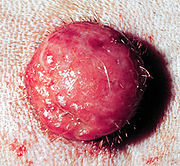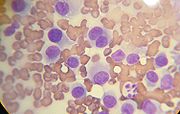
Histiocytoma (dog)
Encyclopedia


Dog
The domestic dog is a domesticated form of the gray wolf, a member of the Canidae family of the order Carnivora. The term is used for both feral and pet varieties. The dog may have been the first animal to be domesticated, and has been the most widely kept working, hunting, and companion animal in...
is a benign tumor. It is an abnormal growth in the skin of histiocyte
Histiocyte
A histiocyte is a cell that is part of the mononuclear phagocyte system . The mononuclear phagocytic system is part of the organism's immune system...
s (histiocytosis
Histiocytosis
In medicine, histiocytosis refers to an excessive number of histiocytes, , and is typically used to refer to a group of rare diseases which share this as a characteristic...
), a cell that is part of the immune system
Immune system
An immune system is a system of biological structures and processes within an organism that protects against disease by identifying and killing pathogens and tumor cells. It detects a wide variety of agents, from viruses to parasitic worms, and needs to distinguish them from the organism's own...
. A similar disease in humans, Hashimoto-Pritzker disease, is also a Langerhans cell histiocytosis
Langerhans cell histiocytosis
Langerhans cell Histiocytosis is a rare disease involving clonal proliferation of Langerhans cells, abnormal cells deriving from bone marrow and capable of migrating from skin to lymph nodes...
. Dog breeds that may be more at risk for this tumor include Bulldog
Bulldog
Bulldog is the name for a breed of dog commonly referred to as the English Bulldog. Other Bulldog breeds include the American Bulldog, Olde English Bulldogge and the French Bulldog. The Bulldog is a muscular heavy dog with a wrinkled face and a distinctive pushed-in nose...
s, Scottish Terrier
Scottish Terrier
The Scottish Terrier , popularly called the Scottie, is a breed of dog. Initially one of the highland breeds of Terrier that were grouped under the name of Skye Terrier, it is one of five breeds of terrier that originated in Scotland, the other four being the modern Skye, Cairn, Dandie Dinmont, and...
s, Greyhound
Greyhound
The Greyhound is a breed of sighthound that has been primarily bred for coursing game and racing, and the breed has also recently seen a resurgence in its popularity as a pedigree show dog and family pet. It is a gentle and intelligent breed...
s, Boxer
Boxer (dog)
Developed in Germany, the Boxer is a breed of stocky, medium-sized, short-haired dog. The coat is smooth and fawn or brindled, with or without white markings. Boxers are brachycephalic , and have a square muzzle, mandibular prognathism , very strong jaws and a powerful bite ideal for hanging on to...
s, and Boston Terrier
Boston Terrier
The Boston Terrier is a breed of dog originating in the United States of America. This "American Gentleman" was accepted in 1893 by the American Kennel Club as a non-sporting breed. Color and markings are important when distinguishing this breed to the AKC standard. They should be either black,...
s. They also rarely occur in goat
Goat
The domestic goat is a subspecies of goat domesticated from the wild goat of southwest Asia and Eastern Europe. The goat is a member of the Bovidae family and is closely related to the sheep as both are in the goat-antelope subfamily Caprinae. There are over three hundred distinct breeds of...
s and cattle
Cattle
Cattle are the most common type of large domesticated ungulates. They are a prominent modern member of the subfamily Bovinae, are the most widespread species of the genus Bos, and are most commonly classified collectively as Bos primigenius...
.
Histiocytic disorders
A histiocyte is a differentiated tissue cell that has its origin in the bone marrowBone marrow
Bone marrow is the flexible tissue found in the interior of bones. In humans, bone marrow in large bones produces new blood cells. On average, bone marrow constitutes 4% of the total body mass of humans; in adults weighing 65 kg , bone marrow accounts for approximately 2.6 kg...
. The source for histiocytes is the monocyte
Monocyte
Monocytes are a type of white blood cell and are part of the innate immune system of vertebrates including all mammals , birds, reptiles, and fish. Monocytes play multiple roles in immune function...
/macrophage
Macrophage
Macrophages are cells produced by the differentiation of monocytes in tissues. Human macrophages are about in diameter. Monocytes and macrophages are phagocytes. Macrophages function in both non-specific defense as well as help initiate specific defense mechanisms of vertebrate animals...
line. Monocytes (found in the blood) and macrophages (found in tissue) are responsible for phagocytosis (ingestion) of foreign material in the body. Langerhans cell
Langerhans cell
Langerhans cells are dendritic cells of the skin and mucosa, and contain large granules called Birbeck granules. They are present in all layers of the epidermis, but are most prominant in the stratum spinosum. They also occur in the papillary dermis, particularly around blood vessels, as well as...
s are dendritic cell
Dendritic cell
Dendritic cells are immune cells forming part of the mammalian immune system. Their main function is to process antigen material and present it on the surface to other cells of the immune system. That is, dendritic cells function as antigen-presenting cells...
s found in the skin and function by internalizing antigen
Antigen
An antigen is a foreign molecule that, when introduced into the body, triggers the production of an antibody by the immune system. The immune system will then kill or neutralize the antigen that is recognized as a foreign and potentially harmful invader. These invaders can be molecules such as...
s (foreign particles) and presenting them to T cell
T cell
T cells or T lymphocytes belong to a group of white blood cells known as lymphocytes, and play a central role in cell-mediated immunity. They can be distinguished from other lymphocytes, such as B cells and natural killer cells , by the presence of a T cell receptor on the cell surface. They are...
s. They arise from monocytes. Histiocytic disorders refer to diseases that are caused by abnormal behavior of these cells. They include the following:
- Reactive diseases of Langerhans cells
- Histiocytomas
- Cutaneous histiocytosis
- Systemic histiocytosis
- Reactive diseases of macrophages
- Hemophagocytic syndrome - a condition where macrophages phagocytose myeloidMyeloidThe term myeloid suggests an origin in the bone marrow or spinal cord, or a resemblance to the marrow or spinal cord.In hematopoiesis, the term "myeloid cell" is used to describe any leukocyte that is not a lymphocyte...
and erythroid precursors (similar to hemophagocytic lymphohistiocytosis in humans)
- Hemophagocytic syndrome - a condition where macrophages phagocytose myeloid
- Malignant diseases of Langerhans cells
- Malignant histiocytosisMalignant histiocytosisMalignant histiocytosis is a rare hereditary disease found in the Bernese Mountain Dog and humans, characterized by histiocytic infiltration of the lungs and lymph nodes. The liver, spleen, and central nervous system can also be affected. Histiocytes are a component of the immune system that...
- a condition found in Bernese Mountain DogBernese Mountain DogThe Bernese Mountain Dog, called in German the Berner Sennenhund, is a large breed of dog, one of the four breeds of Sennenhund-type dogs from the Swiss Alps. The name Sennenhund is derived from the German "Senne" and "hund" , as they accompanied the alpine herders and dairymen called Senn...
s - Diffuse histiocytic sarcoma
- Localized histiocytic sarcoma
- Malignant histiocytosis
- Malignant diseases of macrophages
- Histiocytic lymphoma
Tumor biology

Antigen-presenting cell
An antigen-presenting cell or accessory cell is a cell that displays foreign antigen complexes with major histocompatibility complex on their surfaces. T-cells may recognize these complexes using their T-cell receptors...
lineage. Spontaneous regression is common in these tumors, and it is mediated by infiltration of CD8
CD8
CD8 is a transmembrane glycoprotein that serves as a co-receptor for the T cell receptor . Like the TCR, CD8 binds to a major histocompatibility complex molecule, but is specific for the class I MHC protein. There are two isoforms of the protein, alpha and beta, each encoded by a different gene...
-expressing T cells followed by expression of Type 1 T helper cell
T helper cell
T helper cells are a sub-group of lymphocytes, a type of white blood cell, that play an important role in the immune system, particularly in the adaptive immune system. These cells have no cytotoxic or phagocytic activity; they cannot kill infected host cells or pathogens. Rather, they help other...
cytokine
Cytokine
Cytokines are small cell-signaling protein molecules that are secreted by the glial cells of the nervous system and by numerous cells of the immune system and are a category of signaling molecules used extensively in intercellular communication...
s (such as Interferon-gamma
Interferon-gamma
Interferon-gamma is a dimerized soluble cytokine that is the only member of the type II class of interferons. This interferon was originally called macrophage-activating factor, a term now used to describe a larger family of proteins to which IFN-γ belongs...
) and recruitment of antitumour effector cells.
Symptoms
Most commonly histiocytomas are found in young dogs and appear as a small, solitary, hairless lump, although Shar PeiShar Pei
The Shar Pei, or Chinese Shar-Pei, is a breed of dog known for its distinctive features of deep wrinkles and a blue-black tongue. The breed comes from China. The name translates to "sand skin" and refers to the texture of its short, rough coat...
s may be predisposed to multiple histiocytomas. They are most commonly found on the head, neck, ears, and limbs, and are usually less than 2.5 cm in diameter. Ulceration of the mass is common. Diagnosis is made through cytology
Cytopathology
Cytopathology is a branch of pathology that studies and diagnoses diseases on the cellular level. The discipline was founded by Rudolf Virchow in 1858. A common application of cytopathology is the Pap smear, used as a screening tool, to detect precancerous cervical lesions and prevent cervical...
of the mass. Cytology reveals cells with clear to lightly basophilic
Basophilic
Basophilic is a technical term used by histologists. It describes the microscopic appearance of cells and tissues, as seen down the microscope, after a histological section has been stained with a basic dye. The most common such dye is haematoxylin....
cytoplasm
Cytoplasm
The cytoplasm is a small gel-like substance residing between the cell membrane holding all the cell's internal sub-structures , except for the nucleus. All the contents of the cells of prokaryote organisms are contained within the cytoplasm...
and round or indented nuclei
Cell nucleus
In cell biology, the nucleus is a membrane-enclosed organelle found in eukaryotic cells. It contains most of the cell's genetic material, organized as multiple long linear DNA molecules in complex with a large variety of proteins, such as histones, to form chromosomes. The genes within these...
with fine chromatin
Chromatin
Chromatin is the combination of DNA and proteins that make up the contents of the nucleus of a cell. The primary functions of chromatin are; to package DNA into a smaller volume to fit in the cell, to strengthen the DNA to allow mitosis and meiosis and prevent DNA damage, and to control gene...
and indistinct nucleoli
Nucleolus
The nucleolus is a non-membrane bound structure composed of proteins and nucleic acids found within the nucleus. Ribosomal RNA is transcribed and assembled within the nucleolus...
.
Treatment
Most histiocytomas will regress within two or three months. Surgical removal may be necessary if the tumor does not regress or if it is growing rapidly to a large size. Histiocytomas should never be treated with an intralesional injection of a corticosteroidCorticosteroid
Corticosteroids are a class of steroid hormones that are produced in the adrenal cortex. Corticosteroids are involved in a wide range of physiologic systems such as stress response, immune response and regulation of inflammation, carbohydrate metabolism, protein catabolism, blood electrolyte...
, as remission relies on recognition of the tumour by the body's immune system which is suppressed by steroids.

